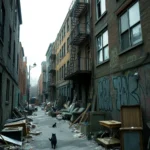Is New York City living really worth the hype?
- Setting the Scene for NYC Living and Safety Concerns
- Key Takeaways: What You’ll Learn About Living in NYC and Its Safety
- The Urban Environment: What Makes New York City Living Unique?
- Crime and Danger in New York City: Separating Fact from Fiction
- Neighborhoods and Safety: Where to Live and What to Avoid
- Daily Life on the Streets: Navigating Safety and Risks in NYC
- Comparing NYC to Other Risky Towns in the US
- The Pros and Cons of Living in New York City Despite Safety Concerns
- Real Voices: Opinions and Experiences from New Yorkers on Safety and Living
- How to Thrive in NYC: Tips for Safe and Enjoyable Living
- Weather and Its Impact on Urban Safety and Lifestyle
- Employment and Job Market: Opportunities Amidst Urban Challenges
- Is New York City Living Really Worth the Hype?
- Sources and Further Reading
Setting the Scene for NYC Living and Safety Concerns
New York City stands tall as one of the most iconic urban centers in the United States. Known worldwide for its towering skyscrapers, bustling streets, and cultural landmarks, it’s a place that draws millions every year. But with all its excitement and opportunity, there’s a flip side that often sparks debate: safety and crime.
Living in NYC means embracing a city that never sleeps, where the energy is electric but the streets can sometimes feel sketchy or risky. The question many ask is: Is New York City living really worth the hype, especially when considering its reputation among dangerous cities in the US? This article will unpack the truth behind that reputation, looking at crime realities, neighborhood safety, lifestyle pros and cons, and what real New Yorkers have to say about their city.
Key Takeaways: What You’ll Learn About Living in NYC and Its Safety
- How NYC’s crime rates compare to other major US cities
- Which neighborhoods are considered safe or more dodgy
- How crime impacts daily life and the overall urban environment
- Real opinions from New Yorkers on safety and living conditions
- Practical tips for navigating the city safely while enjoying its perks
The Urban Environment: What Makes New York City Living Unique?
New York City is home to over 8 million people spread across five boroughs: Manhattan, Brooklyn, Queens, The Bronx, and Staten Island. This massive population creates a dynamic and diverse urban environment unlike any other in the US.
The city’s 24/7 lifestyle means there’s always something happening — from late-night diners to bustling subway stations. This nonstop energy fuels opportunities in business, arts, and culture but also brings challenges like noise, crowds, and safety concerns.
NYC’s reputation as a cultural melting pot is well-earned. People from all walks of life and backgrounds call it home, contributing to its rich tapestry of neighborhoods and communities. This diversity is a huge draw but also means that safety and quality of life can vary widely from one block to the next.
Crime and Danger in New York City: Separating Fact from Fiction
Before diving into the details, let’s clarify some terms often tossed around when discussing crime:
- Crime rates The number of reported crimes per population size.
- Gang violence Crimes linked to organized groups.
- Urban decay Areas suffering from neglect, often with abandoned buildings and less community investment.
- Police presence The visibility and activity of law enforcement in an area.
Recent statistics show that while NYC has had its share of crime, its overall crime rates have dropped significantly over the past two decades. When compared to other major US cities like Chicago, Baltimore, Detroit, St. Louis, Philadelphia, Oakland, and Memphis, NYC often ranks lower in violent crime rates.
Common crimes in NYC include petty theft, such as pickpocketing, especially in crowded tourist areas, and occasional violent incidents. Drug-related issues persist in some neighborhoods but are generally managed by law enforcement efforts.
Crime is not evenly spread across the city. Some neighborhoods are known for being safe and family-friendly, while others have reputations for being more shady or dicey. It’s important to understand these differences rather than paint the entire city with one brush.
Contrary to some myths, NYC is not the most dangerous city in the US. Its crime challenges are real but often exaggerated in media portrayals. Many residents feel safe in their communities and take pride in the city’s resilience.
Neighborhoods and Safety: Where to Live and What to Avoid
Each borough in NYC offers a distinct vibe and safety profile:
- Manhattan The heart of the city, with high rents and a mix of safe, upscale areas and some rough neighborhoods on the edges.
- Brooklyn Known for its cultural scenes and growing neighborhoods, though some parts are considered dodgy.
- Queens Diverse and residential, with many safe neighborhoods but also some risky spots.
- The Bronx Historically faced challenges with crime but has seen improvements; some areas remain wild or messed-up.
- Staten Island Generally quieter and safer, with a suburban feel.
| Neighborhood | Crime Rate (per 1,000 residents) | Average Rent (1BR, approx.) | Vibe |
|---|---|---|---|
| Upper East Side (Manhattan) | Low | $3,200 | Safe, upscale, family-friendly |
| Williamsburg (Brooklyn) | Moderate | $2,800 | Trendy, artsy, mixed safety |
| Astoria (Queens) | Low to moderate | $2,200 | Diverse, residential, safe |
| South Bronx | High | $1,200 | Challenging, improving, some risky spots |
| St. George (Staten Island) | Low | $1,700 | Quiet, suburban, safe |
Community efforts and neighborhood watch programs play a big role in improving safety. Residents often warn visitors and newcomers about areas with poor lighting or less police presence, especially at night.

Living in NYC means dealing with crowded subways, busy streets, and a nightlife that can be both thrilling and unpredictable. Staying safe involves being aware of your surroundings, especially in less familiar areas.
Locals often share tips like avoiding poorly lit streets at night, keeping valuables out of sight, and using trusted transportation options. Police presence varies by neighborhood and time of day, with community programs helping to bridge gaps.
Homelessness and urban decay can affect perceptions of safety, but many neighborhoods have active organizations working to support vulnerable populations and maintain public spaces.
Comparing NYC to Other Risky Towns in the US
When stacked against other sketchy cities in America like Chicago, Baltimore, Detroit, and Philadelphia, NYC’s crime profile is complex but often less severe in violent crime rates.
| City | Violent Crime Rate (per 100,000) | Property Crime Rate (per 100,000) | Urban Environment | Safety Measures |
|---|---|---|---|---|
| New York City | 350 | 1,200 | Dense, diverse, 24/7 | Strong police presence, community programs |
| Chicago | 950 | 1,500 | Large, with high gang activity | Targeted policing, ongoing challenges |
| Baltimore | 1,100 | 1,400 | Urban decay, economic struggles | Community efforts, police reforms |
| Detroit | 1,200 | 1,300 | Post-industrial decline, vacant areas | Revitalization projects ongoing |
While NYC has its risky parts, many find it more manageable and attractive due to its opportunities and vibrant life.
The Pros and Cons of Living in New York City Despite Safety Concerns
Pros
- Abundant job opportunities across industries
- Rich cultural scene with theaters, museums, and music
- Diverse food options and entertainment
- Vibrant, multicultural communities
Cons
- High cost of living, especially housing
- Noise, crowds, and fast pace can be overwhelming
- Some unsafe spots and rough neighborhoods
- Stress related to urban challenges
Many New Yorkers balance these factors by choosing neighborhoods carefully and embracing the city’s energy while staying cautious.
Real Voices: Opinions and Experiences from New Yorkers on Safety and Living
“I’ve lived in Brooklyn for 10 years, and while some areas can feel dicey at night, I’ve never felt unsafe during the day. It’s all about knowing your neighborhood.” – Reddit user, r/AskNYC
“The city has its messed-up parts, but the community here is strong. We look out for each other, and that makes a big difference.” – Local forum comment, NYC Forums
“I avoid certain subway lines late at night because of past incidents, but overall, NYC feels safer than some other cities I’ve lived in.” – Twitter user, #NYCSafety
How to Thrive in NYC: Tips for Safe and Enjoyable Living
- Choose housing in neighborhoods with good lighting and active community watch
- Use public transportation during busy hours and stay alert
- Find local hangouts and chill spots away from gnarly areas
- Stay updated on neighborhood safety through apps and local news
- Engage with community programs to build connections and support
Embracing NYC’s energy while staying cautious helps you enjoy all the city has to offer without unnecessary risks.
Weather and Its Impact on Urban Safety and Lifestyle
NYC experiences four distinct seasons, each affecting daily life and safety differently.
- Winter Snow and ice can make streets slippery and transit slower, increasing accident risks.
- Spring Milder weather encourages outdoor activities but also brings crowded parks and events.
- Summer Hot, humid days lead to busy streets and sometimes increased petty crime in crowded areas.
- Fall Cooler temps and festivals make it a popular time, with generally safer conditions.
Adjusting your routines seasonally can help you stay safe and comfortable in NYC’s changing climate.
Employment and Job Market: Opportunities Amidst Urban Challenges
NYC’s job market is vast, spanning finance, tech, arts, healthcare, and more. Safety concerns sometimes influence commuting choices, with many opting for jobs near home or remote work options.
Finding employment in safer neighborhoods or companies with flexible policies can ease stress related to urban risks. Networking and community connections also play a key role in navigating NYC’s competitive job scene.
Is New York City Living Really Worth the Hype?
Living in New York City is a complex mix of excitement, opportunity, and challenges. While safety concerns and risky neighborhoods exist, many residents find ways to navigate the city wisely and enjoy its unique vibe.
The city’s cultural richness, job prospects, and diverse communities often outweigh the drawbacks for those ready to embrace the hustle. Ultimately, whether NYC living is worth it depends on your priorities, lifestyle, and willingness to adapt.
Sources and Further Reading
- Housing Anywhere: Living in New York
- Reddit r/AskNYC: What is it like to live in NYC?
- Hotbot: The Realities of Living in New York
- United Van Lines: Living in New York
- Mayflower: Moving to New York City
- Hacker News: Is living in NYC worth it?
- Undivided RE: Why You'll Love Living in NYC
- AMNY: NYC Ranks Low for Comfortable Living
What do you think about living in New York City? Have you experienced any risky or sketchy spots yourself? How would you balance the city's excitement with safety concerns? Share your thoughts, questions, or stories in the comments below!
 Is New York City the worst place to live? Shocking truths revealed
Is New York City the worst place to live? Shocking truths revealed Is New York City family safety a myth? What every parent must know now
Is New York City family safety a myth? What every parent must know nowSi quieres conocer otros artículos parecidos a Is New York City living really worth the hype? puedes visitar la categoría New York.

Leave a Reply